

Danse Macabre. A popular saying in the Middle Ages was Momento mori – “remember that you must die.” This was a constant reminder that every living human, rich or poor, young or old, must eventually die. Silly Symphony Skeleton Dance. “The Skeleton Dance” is a short animated film produced by Walt Disney and animated by Ub Iwerks, Walt Disney, Les Clark, Roy O.
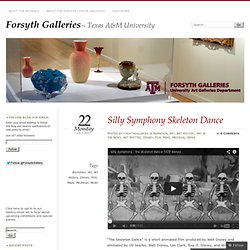
Disney, and Wilfred Jackson. It was released on the 22nd of August, 1929, and has become an iconic, classic animated short to watch during the Halloween season. The total budget for the animation was $5,386, which calculates out to $72,886.44 if it had been produced in 2012. Changing Hands Bookstore. Marduk - La Grande Danse Macabre Lyrics. The Medieval Dance of Death. (French, Dance Macabre, Germ.
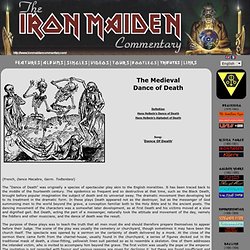
Todtentanz) The "Dance of Death" was originally a species of spectacular play akin to the English moralities. It has been traced back to the middle of the fourteenth century. The epidemics so frequent and so destructive at that time, such as the Black Death, brought before popular imagination the subject of death and its universal sway. The dramatic movement then developing led to its treatment in the dramatic form. The purpose of these plays was to teach the truth that all men must die and should therefore prepare themselves to appear before their Judge. The oldest traces of these plays are found in Germany, but we have the Spanish text for a similar dramatic performance dating back to the year 1360, La Danza General de la Muerte. Danse Macabre. By Kyla Ward First Appeared in Tabula Rasa#2, 1994 Go to timeline entry(2) "You remind me of life in the Middle Ages.
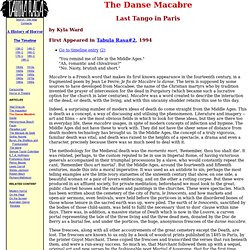
" "Ah, romantic and chivalrous? " "No. Macabre is a French word that makes its first known appearance in the fourteenth century, in a fragmented poem by Jean Le Fevre; Je fis de Macabre la danse. Indeed, a surprising number of modern ideas of death do come straight from the Middle Ages. The Dance of Death. The artistic genre of the dance of death was most probably developed in France.
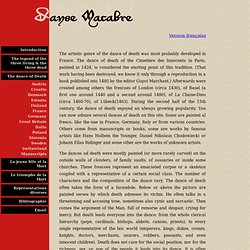
The dance of death of the Cimetière des Innocents in Paris, painted in 1424, is considered the starting point of this tradition. (That work having been destroyed, we know it only through a reproduction in a book published into 1485 by the editor Guyot Marchant.) Afterwards were created among others the frescoes of London (circa 1430), of Basel (a first one around 1440 and a second around 1480), of La Chaise-Dieu (circa 1460-70), of Lübeck(1463). The Danse Macabre Collection. Title: Der Tod von Basel : acht Holzschnitte von Rudolf Schiestl zu dem alten Volksliede [LINK]Author: Rudolf Schiestl, 1924 Title: Ein moderner Totentanz : dreiundzwanzig Blätter aus dem Bilderbuch des Todes [LINK]Author: Tobias Weiss, 1913 Title: La Danse des Morts à Bâle [LINK]Illustrator: (after) Hans Holbein, 1846.

Danse Macabre Dance of Death. Dance of Death. Gallows humor. Gallows humor is humor in the face of or about very unpleasant, serious, or painful circumstances.
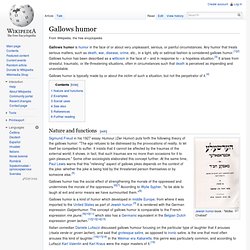
Any humor that treats serious matters, such as death, war, disease, crime, etc., in a light, silly or satirical fashion is considered gallows humor.[1][2] Gallows humor has been described as a witticism in the face of – and in response to – a hopeless situation.[3] It arises from stressful, traumatic, or life-threatening situations, often in circumstances such that death is perceived as impending and unavoidable. Gallows humor is typically made by or about the victim of such a situation, but not the perpetrator of it.[4] Nature and functions[edit] Gallows humor has the social effect of strengthening the morale of the oppressed and undermines the morale of the oppressors.[6][7] According to Wylie Sypher, "to be able to laugh at evil and error means we have surmounted them. Examples[edit] From William Shakespeare's play Romeo and Juliet, Act 3, Scene 1: Social uses[edit] See also[edit]
Medieval dance. Carol[edit] Chretien de Troyes[edit] Some of the earliest mentions of the carol occur in the works of the French poet Chretien de Troyes in his series of Arthurian romances.
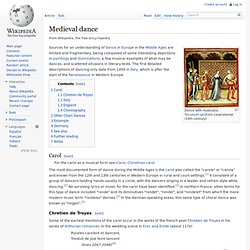
In the wedding scene in Erec and Enide (about 1170) Puceles carolent et dancent, Trestuit de joie feire tancent (lines 2047-2048)[4] "Maidens performed rounds and other dances, each trying to outdo the other in showing their joy"[5] Danse Macabre. Dance of Death. Danse macabre by Charles Baudelaire. Danse Macabre, or the Macabray in The Graveyard Book. The Danse Macabre, or, as the graveyard folks call it, the Macabray, is a dance between the living and the dead.

(By the way, anything that deals with death can be called “macabre.” For example, “She has a macabre interest in books about ghosts and ghouls.”) The dance has been performed (by live people) and shown in art and literature as far back as the 1400s, though we wouldn’t be surprised if the idea has lasted for as long as there have been living people, dead people, and dancing. It’s thought to be a response to the plagues that were killing people left and right hundreds of years ago.
The idea that the dead and living can come together in dance was (and is) comforting to people who have lost loved ones.